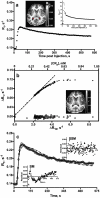DCE-MRI of Brain Fluid Barriers: In Vivo Water Cycling at the Human Choroid Plexus
- PMID: 34542012
- PMCID: PMC8794257
- DOI: 10.1080/21688370.2021.1963143
DCE-MRI of Brain Fluid Barriers: In Vivo Water Cycling at the Human Choroid Plexus
Abstract
Metabolic deficits at brain-fluid barriers are an increasingly recognized feature of cognitive decline in older adults. At the blood-cerebrospinal fluid barrier, water is transported across the choroid plexus (CP) epithelium against large osmotic gradients via processes tightly coupled to activity of the sodium/potassium pump. Here, we quantify CP homeostatic water exchange using dynamic contrast-enhanced MRI and investigate the association of the water efflux rate constant (kco) with cognitive dysfunction in older individuals. Temporal changes in the longitudinal relaxation rate constant (R1) after contrast agent bolus injection were measured in a CP region of interest in 11 participants with mild cognitive dysfunction [CI; 73 ± 6 years] and 28 healthy controls [CN; 72 ± 7 years]. kco was determined from a modified two-site pharmacokinetic exchange analysis of the R1 time-course. Ktrans, a measure of contrast agent extravasation to the interstitial space was also determined. Cognitive function was assessed by neuropsychological test performance. kco averages 5.8 ± 2.7 s-1 in CN individuals and is reduced by 2.4 s-1 [ca. 40%] in CI subjects. Significant associations of kco with global cognition and multiple cognitive domains are observed. Ktrans averages 0.13 ± 0.07 min-1 and declines with age [-0.006 ± 0.002 min-1 yr-1], but shows no difference between CI and CN individuals or association with cognitive performance. Our findings suggest that the CP water efflux rate constant is associated with cognitive dysfunction and shows an age-related decline in later life, consistent with the metabolic disturbances that characterize brain aging.
Keywords: Blood-CSF barrier; DCE-MRI; Na+/K+-ATPase; choroid plexus; water transport.
Conflict of interest statement
No potential conflict of interest was reported by the author(s).
Figures





References
-
- Johanson CE, Keep RF.. Blending established and new perspectives on choroid plexus-CSF dynamics. In: Praetorius J, Blazer-Yost B, Damkier H, editors. Role of the choroid plexus in health and disease. New York (NY): Springer; 2020. p. 35–81.
Publication types
MeSH terms
Substances
Grants and funding
LinkOut - more resources
Full Text Sources
Miscellaneous
